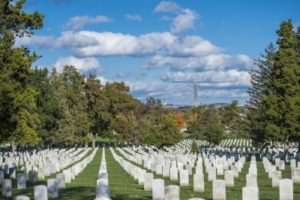Legislators Raise Questions About the Process

Veterans’ survivors testified at a congressional hearing recently that raised questions about the difficulty for them to get benefits. The photo shows graves at Arlington Cemetery. Photo from arlingtoncemetary.mil.
WASHINGTON — Part of VA’s mission is to care for the widows and orphans of servicemembers and veterans, but some legislators have expressed concern that survivors are getting short shrift, especially when the veteran dies long after their initial service rather than in combat.
At a House VA Subcommittee on Disability Assistance hearing last month–the first held on this topic in over a decade–lawmakers and family advocates presented one story after another of widows and other caregivers who, when they looked for information on survivors benefits and other VA support, were met with a confusing bureaucracy or were simply dismissed by VA staff.
“[Through a committee survey, we’ve heard] numerous stories of survivors of deceased veterans having difficulty communicating with VA, filing claims, doing simple paperwork and, when they were able to contact the agency, being rushed off the phone,” declared Committee Chair Rep. Elaine Luria (D-VA). “Some survivors say they feel like second-class citizens when they contact VA.”
In 2020, VA began a campaign designed to reach out to this population because they were experiencing an increase in the number of survivors seeking information. Part of that increase was likely due to changes in disability laws adding new presumptive conditions, including many caused by Agent Orange. This allowed survivors to apply or reapply for benefits that they might not have been eligible for before.
Recent events also might have survivors seeking information from VA, however. Last month, VA reached the grim milestone of 20,000 veterans dead from COVID-19. And, if legislators or VA were to create a presumption of service in connection to the conditions potentially caused by toxins from burn pits—an effort that is currently underway in Congress—it would expand benefits to millions of veterans, as well as an estimated 70,000 survivors. The same estimate suggests that as many as 110,000 survivors of veterans who died from toxic exposure would be eligible for survivor benefits by 2031.
Mark Belinsky, speaking for the Military Officers Association of America, testified that, “Some survivors are reckoning that this exposure was likely the root cause of death for their veteran. [One survivor told us] ‘With leukemia, we never thought of applying for disability until years after my husband’s death. The shameful thing is, when I went to a VA office and asked about it, they said they couldn’t help me, because I wasn’t a veteran and my husband should have made a claim before he died. I was so intimidated, it took me five years to reach out to a [veteran service organization] for help.”
VA officials testified that, because they didn’t have metrics in place, the department did not know how effective its 2020 information campaign had been.
“We don’t have the tools in place to measure the effectiveness of outreach,” explained Cheryl Rawls, director of VBA’s Outreach, Transition and Economic Development Service. “That is one of the items we have been in constant communication about with our veterans’ experience office. We know we need to be able to hear from that population once we’ve done outreach. We’re currently in the process of setting up a mechanism to get that feedback that will give us very immediate information as to how much service we’ve provide and areas we need to continue to focus on.”
In 2020, VA’s Office of Survivor Assistance commissioned the creation of a Survivors’ Journey Map. The map describes the end-to-end survivor experience and its major intersections with VA. The map includes the emotions survivors may experience, the people they encounter and the challenges they face. As a result of creating this map, VA now includes survivor benefits in all of its outreach engagements.
“Last year, we did almost 125 combined activities between the Office of Outreach and the Office of Survivor Assistance,” Rawls said. “This year, the offices are already completed 100 engagements, and we are continuing to ensure we’re working with either our women’s veterans coordinators, our elderly coordinators, our state directors, so we have a presence in activities, so we can get to that population.”
Some veterans’ advocates want VA to close the gap even further and provide survivors of veterans who die after their service to receive the same kind of assistance that a family of a servicemember killed during active duty receives. Family of active duty servicemembers are assigned a casualty assistance officer to help them through the grief and navigating the benefits system.
“That initial point of contact upon notification of the veteran’s death is important,” explained Pamela Laurion, representing the Gold Star Wives of America. “The grief process for a widow when a spouse dies [leaves] that spouse with an inordinate amount of paperwork and emotional trauma and financial trauma. So having that point of initial contact [can provide] assistance with paperwork, provide more information, follow-up with that spouse to make sure they’ve applied for that benefit, and gentle reminders that this is available for you. So they can move forward with their benefits.”

